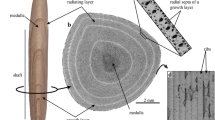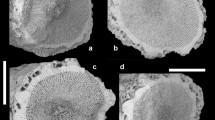Summary
The long and slender spines of Diadema are highly flexible, although their skeleton consists mainly of CaCO3 and behaves optically like a single monocrystal of calcite. The flexibility is due to the shape of the spine skeleton as well as to the material properties of the echinoderm calcite.
The spine skeletons are hollow beams consisting of radial wedges or septs. The shape of the septs shows a broad base situated at the periphery of the cross section, producing a high load-bearing capacity with minimum weight. Furthermore, material is concentrated at the base of the spine in such a way that the strain of the structure is kept constant along the axis. The septs are connected with one another by a few transverse bars positioned as closely as possible to the axis. The load-bearing parts of the septs are free. They have small diameters similar to flexible glass fibres. The stiff spines of other echinoids are also mainly built by radial wedges, but the spaces in between are closely filled with transverse bars. On the surface of stiff spines there are low grooves between the septs. The echinoid spines are covered with an epithelium which shows a basiepithelial nerve plexus. In the stiff spines this plexus forms cords which lie protected within the superficial grooves mentioned. In the flexible spines of Diadema the cords are deeply sunken in the spaces between the septs. In this manner the nerve cords are largely free from the tensile stresses to which the spine's surface is exposed.
The flexible spines were used to determine the material properties of echinoderm calcite. Young's modulus was determined for fresh (live) spines, dry spines, and cleaned spine skeletons. Fresh spines show the highest elasticity, and their Young's modulus is significantly below the Young's modulus of the other test groups. The echinoderm calcite does not show the cleavage planes of mineral calcite, and probably this feature contributes to the high flexibility of echinoderm calcite.
Similar content being viewed by others
References
Alexander RMcN (1971) Animal mechanics. Sidgwick & Jackson, London
Becher S (1914) Über statische Strukturen und kristalloptische Eigentümlichkeiten des Echinodermenskeletts. Verh Dtsch Zool Ges 24:307–327
Currey JD (1975) A comparison of the strength of echinoderm spines and mollusc shells. J Mar Biol Ass UK 55:419–424
D'Ans J, Lax E (1964) Taschenbuch für Chemiker und Physiker. Berlin Heidelberg New York: Springer
Donnay G, Pawson DL (1969) X-ray diffraction studies of echinoderm plates. Science 166:1147–1150
Fontaine AR, Hall BD (1981) Biocompatibility of echinoderm skeleton with mammalian cells in vitro: Preliminary evidence. J Biomed Mat Res 15:61–71
Hamann O (1887) Beiträge zur Histologie der Echinodermen. Fischer, Jena
Hansmann W (1978) GRAFEIN — Ein Programm zur dialogunterstützten Erfassung allgemeiner graphischer Information. IKP-Bericht, Ruhr-Universität Bochum 1
Heatfield BM, Travis DF (1975) Ultrastructural research of regenerating spines of the sea urchin Strongylocentrotus purpuratus I. Cell types without spherules. J Morphol 145:13–50
Hessel JFG (1826) Einfluß des organischen Körpers auf den unorganischen. JC Krieger u. Co, Marburg
Hilgers H, Splechtna H (1981) Zur Feinstruktur ophiocephaler Pedizellarien von Arbacia lixula. Zoomorphology 97:89–100
Inoué S, Okazaki K (1977) Biocrystals. Sci Amer 236:83–92
Mackintosh HW (1875) Researches on the structure of the spines of the Diadematidae. Trans R Ir Acad 25:519–558
Märkel K, Kubanek F, Willgallis A (1971) Polykristalliner Calcit bei Seeigeln. Z Zellforsch Mikrosk Anat 119:355–377
Millott N (1950) The sensitivity to light, reactions to shading, and color change of the sea urchin Diadema antillarum. Biol Bull Mar Biol Lab 99:329–330
Mischor B (1975) Zur Morphologie und Regeneration der Hohlstacheln von Diadema antillarum Philippi und Echinothrix diadema (L). Z Morphol Tiere 82:243–258
Mortensen Th (1940) A Monograph of Echinoidea III, 1. Reitzel CA, Copenhagen
Nachtigall W (1971) Biotechnik. Quelle und Meyer, Heidelberg
Nachtigall W (1973) Konstruktionsmorphologie: Funktionelle Gestaltung biologischer Stützelemente und Trägerstrukturen. Verh Dtsch Zool Ges 66:4–15
Nachtigall W (1977) Minimalkostruktionen in der Biologie: Baustoffe und Materialanordnung. In: Bubner E, Baier B, Koenen R, Oelbermann J (eds) Minimalkonstruktionen. Rudolf Müller, Köln, pp 223–245
Nichols D, Currey JD (1968) The secretion, structure, and strength of echinoderm calcite. In: McGee-Russel SM, Ross KFA (eds) Cell structure and its interpretation. Arnold, London, pp 251–261
Pilkington JB (1969) The organisation of skeletal tissue in the spines of Echinus esculentus. J Mar Biol Ass UK 49:857–877
Takahashi K (1967) The catch apparatus of the sea urchin spine. I. Gross histology. J Fak Sci Univ Tokyo, Sect 4, Zool 11:109–120
Towe K (1967) Echinoderm calcite: Single crystal or polycrystalline aggregate. Science 157:1048–1050
Uexküll Jv (1900) Die Physiologie des Seeigelstachels. Z Biol 39:72–112
Wainwright SA, Biggs WD, Currey JD, Gosline JM (1976) Mechanical Design in Organisms. Arnold, London
Weber J, Greer R, Voight B, White E, Roy R (1969) Unusual strength properties in echinoderm calcite related to structure. J Ultrastr Res 26:355–366
Weber W, Grosmann M (1977) Ultrastructure of the basiepithelial nerve plexus of the sea urchin Centrostephanus longispinus. Cell Tissue Res 175:551–562
Author information
Authors and Affiliations
Rights and permissions
About this article
Cite this article
Burkhardt, A., Hansmann, W., Märkel, K. et al. Mechanical design in spines of diadematoid echinoids (Echinodermata, Echinoidea). Zoomorphology 102, 189–203 (1983). https://doi.org/10.1007/BF00310347
Received:
Issue Date:
DOI: https://doi.org/10.1007/BF00310347




